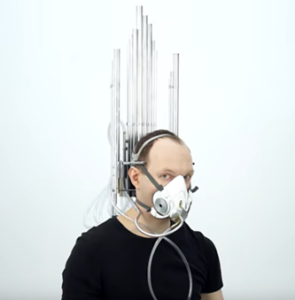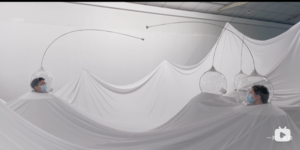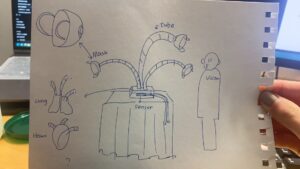Overview: My initial idea , case study and Philly’s feedback
In the post-pandemic era, we have begun to reevaluate the significance of breathing. It is not only a fundamental condition for survival but also a means of regulating the body and mind, an invisible connection between individuals and the world. The pandemic forced us to experience a time when breathing was restricted, and air was perceived as something to be cautious about. Now, have we truly learned to coexist with our own breath?
This installation aims to visualize the act of breathing, transforming it into a therapeutic experience. It guides participants to focus on their own rhythm, perceive the flow of air within their bodies and the surrounding space, and return to a state of inner calm.
Case Study
“Vicious Circular Breathing” — This artwork forces participants to breathe in their own exhaled air, creating a sense of tension and suffocation, emphasizing the restriction and anxiety associated with breath.
My reflection: How can I reverse this effect, making breath feel light and free rather than heavy and oppressive?

“Last Breath” — This work records and stores a person’s final breath, giving breath a sense of time and life’s significance.
My reflection: Can breath be more than just a record of the past? Can it become a way to experience the present, allowing the audience to find healing through their own breathing?

“当呼吸可以言语(When Breathing Becomes Language)” — This piece transforms breathing into a form of communication, stripping away the complexity of language and returning to a fundamental, bodily mode of interaction.
My reflection: If breath can connect people, can it also serve as a tool for self-regulation, relaxation, and meditation?

My Idea: A Tree Formed by Transparent Tubes
Interactive Experience
- Participants wear a mask, which connects to the installation’s tubes.
- Their breath travels along the transparent tubes, ultimately converging in a central container, possibly shaped like lungs or a heart, symbolizing life and connection.
- Sensors track the airflow and convert the data into visual and auditory feedback, making the act of breathing visible, audible, and tangible.

Feedback
During our discussion, Philly provided several key insights and suggestions, which deepened my understanding of the installation’s details:
The Use of Masks
- Incorporating masks in the installation effectively evokes memories of restricted breathing during the pandemic, but it may also cause discomfort or limit the participant’s sense of freedom, potentially disrupting the calming experience.
- Suggestion: Consider a replaceable design or an alternative microphone-like device that allows participants to interact more naturally without fully wearing a mask.
Optimizing the Sensor Placement
- In the current design, air travels through the tubes into the central container before being detected by the sensors, which may cause data loss and reduce accuracy.
- Suggestion: Place the sensors closer to the participant’s breathing source, such as at the entrance of the tube, to directly capture variations in breath while still preserving the airflow visualization effect.
Balancing the Atmosphere & Theme
- If the installation aims to create a therapeutic and relaxing experience, an excessive use of medical-like elements (e.g., tubes and masks) might evoke a sense of restriction rather than relaxation.
- Reflection: Clarify whether the installation is more focused on immersive healing or if it carries a critical perspective on medical environments.
- Potential Adjustments: Use lighting, sound, and material choices to create a softer and more inviting atmosphere, ensuring that participants feel a sense of calm rather than an association with medical settings.

